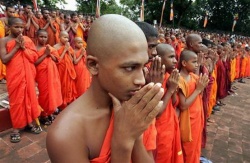The Indian Systems of Philosophy
- The Hindus classify the systems of philosophy into two classes, namely, the _nastika_ and the _astika_. The nastika (_na asti_ "it is not") views are those which neither regard the Vedas as infallible nor try to establish their own validity on their authority.
These are principally three in number, the Buddhist, Jaina and the Carvaka. The astika-mata or orthodox schools are six in number,
Yoga,
Nyaya and
generally known as the six systems (_saddars'ana_ [Footnote ref 93]).
The Samkhya is ascribed to a mythical Kapila, but the earliest works on the subject are probably now lost. The Yoga system is attributed to Patanjali's and the original sutras are called the _Patanjala Yoga sutras_.
The general metaphysical position of these two systems with regard to soul, nature, cosmology and the final goal is almost the same, and the difference lies in this that the Yoga system acknowledges a god (_Is'vara_) as distinct from Atman and lays much importance on certain mystical practices (commonly known as Yoga practices) for the achievement of liberation, whereas the Sa@mkhya denies the existence of Is'vara and thinks that sincere philosophic thought and culture are sufficient to produce the true conviction of the truth and thereby bring about liberation.
It is probable that the system of Samkhya associated with Kapila and the Yoga system associated with Patanjali's are but two divergent modifications of an original Sa@mkhya school, of which we now get only references here and there.
These systems therefore though generally counted as two should more properly be looked upon as two different schools of the same Sa@mkhya system--one may be called the Kapila Samkhya and the other Patanjala Samkhya.
The Purva Mimamsa (from the root _man_ to think--rational conclusions) cannot properly be spoken of as a system of philosophy. It is a systematized code of principles in accordance with which the Vedic texts are to be interpreted for purposes of sacrifices.
The Vedic texts were used as mantras (incantations) for sacrifices, and people often disputed as to the relation of words in a sentence or their mutual relative importance with reference to the general drift of the sentence.
There were also differences of view with regard to the meaning of a sentence, the use to which it may be applied as a mantra, its relative importance or the exact nature of its connection with other similar sentences in a complex Vedic context.
The Mima@msa formulated some principles according to which one could arrive at rational and uniform solutions for all these difficulties. Preliminary to these its main objects, it indulges in speculations with regard to the external world, soul, perception, inference, the validity of the Vedas, or the like, for in order that a man might perform sacrifices with mantras, a definite order of the universe and its relation to man or the position and nature of the mantras of the Veda must be demonstrated and established.
Though its interest in such abstract speculations is but secondary yet it briefly discusses these in order to prepare a rational ground for its doctrine of the mantras and their practical utility for man. It is only so far as there are these preliminary discussions in the Mimamsa that it may be called a system of philosophy.
Its principles and maxims for the interpretation of the import of words and sentences have a legal value even to this day.
The sutras of Mimamsa are attributed to Jaimini, and S'abara wrote a bhasya upon it. The two great names in the history of Mimamsa literature after Jaimini and S'abara are Kumarila Bha@t@ta and his pupil Prabhakara, who criticized the opinions of his master so much, that the master used to call him guru (master) in sarcasm, and to this day his opinions pass as _guru-mata_, whereas the views of Kumarila Bha@t@ta pass as _bhatta-mata_ [Footnote ref 94]. It may not be out of place to mention here that Hindu Law (_smrti_) accepts without any reservation the maxims and principles settled and formulated by the Mimamsa.
The _Vedanta sutras_, also called Uttara Mimamsa, written by Badarayana, otherwise known as the _Brahma-sutras_, form the original authoritative work of Vedanta. The word Vedanta means "end of the Veda," i.e. the Upanisads, and the _Vedanta sutras_ are so called as they are but a summarized statement of the general views of the Upani@sads. This work is divided into four books or adhyayas and each adhyaya is divided into four padas or chapters. The first four sutras of the work commonly known as _Catuhsutri_ are
(1) How to ask about Brahman, (2) From whom proceed birth and decay, (3) This is because from him the Vedas have come forth,
(4) This is shown by the harmonious testimony of the Upani@sads. The whole of the first chapter of the second book is devoted to justifying the position of the Vedanta against the attacks of the rival schools. The second chapter of the second book is busy in dealing blows at rival systems.
All the other parts of the book are devoted to settling the disputed interpretations of a number of individual Upanisad texts.
The really philosophical portion of the work is thus limited to the first four sutras and the first and second chapters of the second book. The other portions are like commentaries to the Upani@sads, which however contain many theological views of the system.
The first commentary of the _Brahma-sutra_ was probably written by Baudhayana, which however is not available now.
The earliest commentary that is now found is that of the great S'ankara. His interpretations of the _Brahma-sutras_ together with all the commentaries and other works that follow his views are popularly known as Vedanta philosophy, though this philosophy ought more properly to be called Vis'uddhadvaitavada school of Vedanta philosophy (i.e. the Vedanta philosophy of the school of absolute monism).
Variant forms of dualistic philosophy as represented by the Vaisnavas, S'aivas, Ramayatas, etc., also claim to express the original purport of the Brahma sutras.
We thus find that apostles of dualistic creeds such as Ramanuja, Vallabha, Madhva, S'rikantha, Baladeva, etc., have written independent commentaries on the _Brahma-sutra_ to show that the philosophy as elaborated by themselves is the view of the Upani@sads and as summarized in the _Brahma-sutras_.
These differed largely and often vehemently attacked S'ankara's interpretations of the same sutras. These systems as expounded by them also pass by the name of Vedanta as these are also claimed to be the real interpretations intended by the Vedanta (Upanisads) and the _Vedanta sutras_. Of these the system of Ramanuja has great philosophical importance.
The _Nyaya sutras_ attributed to Gautama, called also Aksapada, and the _Vais'esika sutras_ attributed to Kanada, called also Uluka, represent the same system for all practical purposes. They are in later times considered to differ only in a few points of minor importance. So far as the sutras are concerned the _Nyaya sutras_ lay particular stress on the cultivation of logic as an art, while the _Vais'esika sutras_ deal mostly with metaphysics and physics.
In addition to these six systems, the Tantras had also philosophies of their own, which however may generally be looked upon largely as modifications of the Sa@mkhya and Vedanta systems, though their own contributions are also noteworthy.


